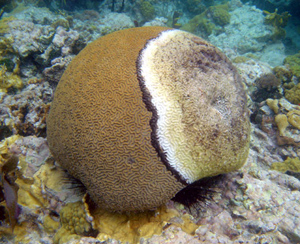Coral reefs offer a rainbow array of colors — red, yellow, purple, and many other vivid shades. But diseases can strip away that color, leaving the coral as pale as a blank sheet of paper — and just as dead, too.
 Brain coral with black-band disease, Waterlemon Cay, Virgin Islands National Park. Credit: Caroline Rogers, USGS
Brain coral with black-band disease, Waterlemon Cay, Virgin Islands National Park. Credit: Caroline Rogers, USGSCoral diseases have spread rapidly over the last couple of decades, affecting reefs around much of the world. The diseases are caused by bacteria, algae, and other tiny organisms. But global climate change, pollution, and other factors may be making the problem worse by providing a more hospitable environment for the disease-causing organisms.
The first coral disease ever documented is known as black band disease. It was first seen near Florida and Belize in the early 1970s. It strikes in summer, when waters are warm and there’s abundant sunlight. The disease occurs when several types of bacteria settle on the coral in a thin, black band. The bacteria consume oxygen and produce hydrogen sulfide, which kills the living coral organisms, leaving only the bleached skeleton.
Once the bacteria settle in, they can move across the coral at rates of up to an inch or so a day. At that speed, it doesn’t take long to destroy a large coral colony.
Black band and other diseases have damaged coral populations in the Caribbean Sea, and have attacked corals in Australia’s Great Barrier Reef and elsewhere. And scientists are concerned that even warmer water temperatures in the years ahead could allow disease organisms to thrive — depriving the oceans of some of their most colorful inhabitants.

